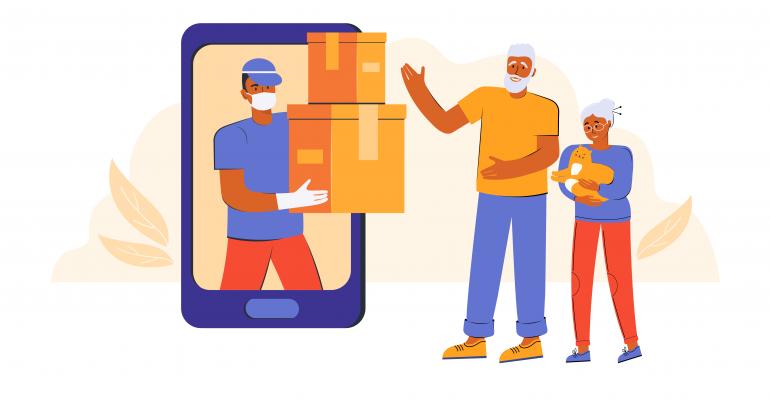One of the biggest questions right now for urban multifamily property managers is how to deal with ramped-up package delivery while ensuring social distancing rules.
Even before the pandemic, many apartment building managers were already experimenting with improving their package delivery processes. But the pandemic has accelerated the demand to find more efficient solutions for deliveries. For example, technology tools can help make it easier to practice social distancing at multifamily buildings, according to Robert Gaulden, director of multifamily channel strategy at Allegion U.S., a provider of security solutions. There are technologies that allow for access control on a particular room inside the building, meaning property managers have the ability to set schedules for when residents can enter the room and ensure they do not have more than a certain number of people in the space at any given time. This technology can apply not only to package delivery rooms, but also to other common areas of the building, says Gaulden.
“Now, you also have to look at the design and say: ‘what do we want that flow to be, what do we want that experience to be, how do we manage this environment to be lower touch?’” Gaulden notes. “Do we put automatic operators in all the way from the exterior to the interior to make sure that the delivery people are not touching as many door handles for example, or entering into the package room? And there’s a question perhaps: does this help accelerate delivery [directly to residents’ units?]”
Draper and Kramer, a Chicago-based property and financial services company, already utilizes a technology-based solution for logging in packages and notifying residents at its buildings, according to Tim Kramer, vice president and director of operations with the firm. However, ensuring efficiency and safety in the current landscape involves customer service-based changes, and Kramer says he has not seen a technological solution that addresses that aspect of building management better than human interaction.
“We’re in constant communication with residents and our teammates,” says Kramer. “The personal touch is more important than ever, which is kind of ironic at a time where close contact is to be avoided.”
Consumers are likely to favor online shopping more than ever, which will apply pressure to property managers’ ability to handle a higher volume of packages not only safely, but also efficiently, Kramer notes. Each property management team will have to figure out the best solution based on the specific building’s physical layout, as well as resident habits, so there will not be a one-size-fits-all solution, he says.
“During these initial months of dealing with the pandemic, we have focused on the safety of our team members and residents by implementing a no-touch delivery process,” says Kramer. “This simply means that, for example, when a resident is picking up their delivery, they let us know they are coming and we place it in an area where they can pick it up without coming into direct contact with anyone else. At our sites with package lockers, we have implemented a much more robust cleaning schedule for the lockers, so they’re wiped down much more frequently.”
Though more high-tech solutions could be reserved primarily for class-A buildings, Gaulden says there are still viable technology tools and good practices that can be implemented across all property classes and building layouts. Still, class-A buildings would have the capital to implement more expensive solutions, such as installing auto operators on every door from the exterior of the building to the package room, so, nobody has to engage physically with the door anymore.
“I think, from a high level, every conversation I’ve been in [is] ‘what are the best practices to ensure that we’re safe?’ and ensuring social distancing is occurring in the building,” says Gaulden. “How do you maintain a clean package area, as well as all other areas like common areas? How do you ensure you have a highly efficient model going forward?”
Mobile credentials could help solve this problem, Gaulden notes. For example, a mobile app would notify residents when their package has arrived. The resident would then make their way down to the package room where a mobile-enabled credential would open the door automatically, meaning residents would not have to touch anything to access their package.
“I think a lot of companies are looking at how do we become more of a touchless solution,” says Gaulden. “And I think package delivery can be lumped into that as well.”

